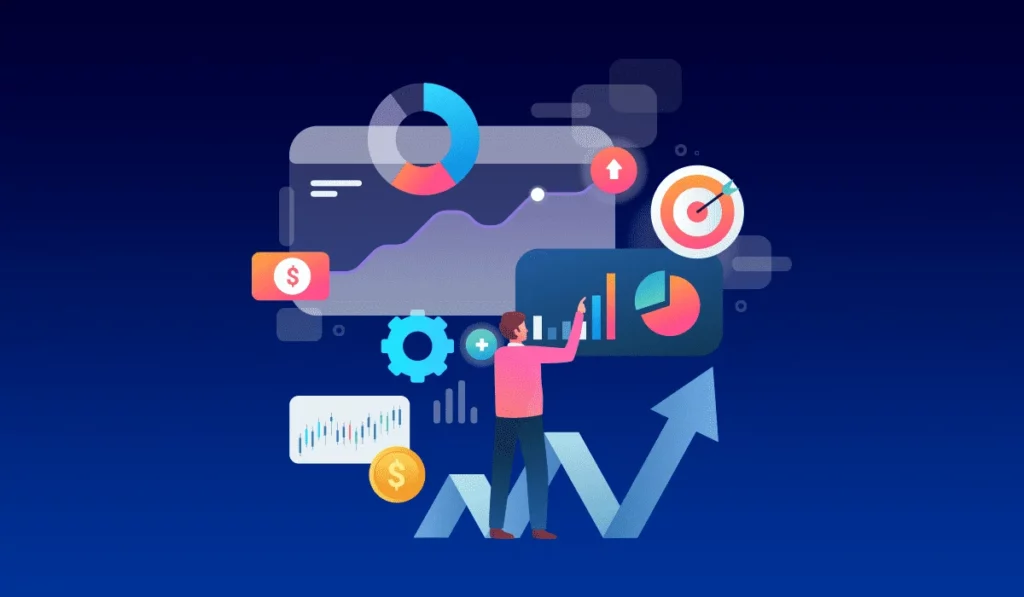Measuring Social Media ROI: Key Metrics and Analytics Tools
Naveen Raj17 Nov 2023
Understanding and measuring Return on Investment (ROI) in social media marketing plays a vital role in shaping future marketing strategies.
When you measure social media ROI, you learn how well your social media marketing for your business is doing and where it can get better. This helps make your current campaigns better and sets smart goals for the future.
Whether you are a business aiming for profits or an individual building a personal brand, knowing and measuring social media ROI is like having a guide to make smart, cost-effective choices in the digital marketing world.

What’s Ahead
What Is Social Media ROI
Social media ROI is a way to figure out how much value you get from what you put into social media. Usually, we measure it in money, but sometimes it’s hard to see direct profits.
In those cases, we use other measures, like more followers or more people seeing your posts, to see if our efforts are paying off.
The things you look at to see your social media ROI depend on what you want to achieve.
If you want to be more famous and influential, you might measure it by how many new followers you get or how many people see your posts.
The key is to use the right measures to see if your social media efforts are getting you closer to your goals.
What Are the Key Social Media Metrics for Calculating ROI
Social media metrics serve as business scorecards in the digital age, assisting in customer engagement, brand establishment, and loyalty. They are indispensable for agencies and social media managers.
These metrics measure the success of campaigns and inform customized strategies. Key indicators include audience growth, engagement, and post shares.
The numbers show how well the campaigns are doing, help find ways to make them better, and make sure they match what the client wants.
Below you can find the 7 social media metrics that help to track the ROI.
Impressions
Impressions show how many times people viewed your content. You can count impressions for each post and for your whole social media profile.
Sometimes, one person might see your content more than once, so the number of impressions can be more than the reach.
If you have a lot of impressions compared to reach, it means people are looking at a post many times.
Reach
Reach means the total count of people who have seen a post since it went live. For instance, on Facebook, we have a special section for reach that provides more information, like:
1. The overall reach
2. The difference between organic (unpaid) and paid reach
3. Details about the age and gender of viewers
4. Information about the top countries, cities, and languages of the audience.
Engagement Metrics
Audience engagement on social media can vary from one platform to another, but it usually involves things like when people give a thumbs-up, leave comments, or share what you’ve posted.
If we take YouTube as an example, there’s a section where you can see numbers and charts that tell you how people are interacting with your videos. This information helps your social media agency to make your already popular content even better.
It’s like a chain reaction; interesting videos lead to a better online presence, more people engaging with what your clients post, and ultimately more sales or actions being taken.
So make sure you are providing engaging content to your social media audience.
Click-Through Rate (CTR)
One crucial metric to watch on social media is the Click-Through Rate (CTR). It shows how effective your content is at getting people from the platform to your clients’ websites.
With the Facebook Ads integration, you can easily track CTR over time in a special dashboard.
By including Facebook Ads data in your reports, you can see which ads are performing best in terms of CTR and cost-per-click (CPC). This will help you make budget-friendly, data-driven marketing decisions.
Conversion Metrics
Conversion rate, or goal completion rate, tells you how many people take the desired action on your website compared to the total number of visitors.
It’s important to check this rate from social media to ensure that your website and content are doing a good job of turning potential customers into actual customers.
You can find this information for each social platform in Google Analytics by going to Acquisition > Social.
Return on Ad Spend(ROAS)
If you are spending money to boost your social media posts, it’s important to check if you’re getting good results.
Many social advertising platforms have a way to do this. For instance, on Facebook Ads, there is a metric called “Website Purchase ROAS” that shows how much money you make from your ads compared to what you spend.
This helps you see if your ad spending is worth it.
Audience Growth Rate
Audience growth rate is a way to measure how many new followers your brand gains on social media in a certain time. It’s not just about counting new followers.
It’s about looking at them as a percentage of your total audience. When you are just starting, even a few new followers can give you a high growth rate.
But as your audience grows, you need more new followers to keep up the pace. To find your audience growth rate, calculate your new followers for a specific time, divide it by your total audience, and multiply by 100 to get the growth rate percentage.
How to Calculate Social Media ROI
Calculating social media ROI can be done in various ways. Some companies keep things straightforward by comparing the amount of money made and spent on social media advertising initiatives.
Others use more complex calculations involving factors like website traffic, leads, and engagement.
Regardless of the approach, the basic ROI formula remains the same:
(Earnings – Investment Made) x 100/ Investment Made = Social Media ROI
The investment made includes the time you invested, Content, Social media tools, and Ad costs.
Tools for Calculating Social Media ROI
Social media ROI tools are handy software that helps businesses understand how well their social media marketing is paying off.
These tools offer different advantages, like better understanding your goals, keeping a close eye on important numbers, and even automating some social media tasks.
Here are five great tools we recommend for measuring social media ROI.
Google Analytics
Google Analytics is a useful tool for measuring how well your social media campaigns are doing. It helps you find out which social platforms bring the most visitors and which content gets the most attention.
You can calculate social media ROI in two ways. First, check how many people visit your website from social media. Go to Acquisition > Social > Network Referrals in Google Analytics to see how many website visits each social platform brings.
You can also monitor conversions from your social ads. Go to Conversions > Goals > Overview to see how many conversions come from each social platform.
By watching these numbers, you can see which social platforms give you the best return on investment. This makes it easier for you to concentrate your efforts and provide content where it matters most.
UTM Parameters
UTM parameters are small tags you add to your website links to track how people interact with your online business. They help you see where your website visitors come from, which social media platforms they use, and how they engage with your content.
You can categorize UTM parameters by things like email, social media, or Google searches, and also by specific marketing campaigns or content, like an Instagram Story.
This data is crucial for calculating your social media ROI, helping you make better online marketing decisions, and pinpointing where your efforts are paying off.
Tracking Pixels and Conversions APIs
When you run social media ads, tracking pixels is crucial for assessing your ad performance.
These pixels let you keep an eye on the folks who come to your website from social ads and see their actions, such as buying things.
They also help you improve your ad targeting and reconnect with potential customers.
But the problem is tracking pixels is not as effective as it used to be.
Platforms like Facebook are fixing this by bringing in the Conversions API, a method to collect data directly from your servers. This makes sure your ad data is more precise and dependable.
Sked Social
Sked Social is a smart platform tailored for Instagram. With Sked Social, you can easily figure out which posts and topics get the most likes and comments from your followers.
It’s an all-in-one tool for Instagram that helps you keep tabs on every sale, message, or new contact you get from your stories and posts.
You can use Sked Social to see how well your Instagram stories are doing. Compare your performance to your competitors, and even check how many people visit your website through the link in your bio.
It’s a versatile tool to keep an eye on your social media and figure out if your Instagram efforts are paying off.
Hootsuite Social Advertising
To cut through the online noise, Hootsuite’s social ROI calculator is a handy tool. It does the number crunching for you.
Just put in your expenses, such as ad spending, and compare them to important metrics like conversions, website traffic, brand recognition, or audience engagement. This assists in determining the best places to allocate your marketing funds.
Clearly defined social media marketing objectives are essential for maximizing the use of the Hootsuite Social ROI Calculator.
If you don’t have clear goals, you might end up focusing on less important numbers like followers and likes which may not really show how well you are doing.
How to Improve Your ROI
Boosting your social media ROI means making more money from the time and effort you put into social platforms.
There are smart strategies and tools to help you get better results and understand what works in the world of social media marketing.
Clearly Outline Your Goals and Objectives
To improve your social media ROI, start by setting clear and realistic goals. These goals are crucial for successful social media marketing. Choose practical objectives, otherwise, you will end up disappointed.
Equally important is picking the right social media measures to see how well you are doing. These measures include matters like followers, engagement, website clicks, and conversion rates.
Keep an eye on these measures as your campaign unfolds. They will show you if you are on the right track. If not, you can change your strategies to match your goals.
This will create a positive impact and provide a good return on your investment.
Understand Your Audience
Figure out who your audience is and what they expect from you on social media. Learn which platforms they prefer and the content they enjoy. Get to know their personality as if they were your best friend.
Be responsive and create a community by replying to comments and messages. Keep adjusting your content to match what your audience likes. This will help you make the most of your social media and get better results.
Optimize Content for Engagement
To do well on social media, make great content that your audience enjoys. Share stuff that’s useful, entertaining, and relevant to them, instead of always selling something.
A good rule to follow is the 80/20 rule: 80% of your posts should be interesting, and only 20% can be promotional.
Use different types of posts, like regular ones, stories, slideshows, and short videos to keep your audience interested. Don’t be afraid to try new things in your content to get more likes and comments.
Focus on Relevant Platforms
To improve your social media ROI, picking the right platform is crucial. Choose one that suits your audience and focus on where they spend their time.
For B2B companies offering web development services, LinkedIn, Reddit, and Quora work well.
If you’re a B2C company catering to women’s needs, go for Facebook, Instagram, and Pinterest.
Don’t waste money on platforms where you don’t get results or interaction. Tailoring your choice to your audience’s preferences is key to success.
Invest in Influencer Marketing
To enhance your social media ROI, consider teaming up with influencers. They can boost your brand image.
Seek out influencers who not only have lots of followers but also resonate with your target audience. It’s crucial to maintain relationships with both local and global influencers because they can effectively promote your brand.
Influencers can expand your content’s reach and boost engagement, leading to improved marketing outcomes. Additionally, influencer marketing can increase your visibility, trustworthiness, and influence, and even boost sales.
Stay Updated on Trends
It’s critical to keep up with trends if you want to increase social media ROI. Observe what is trending and important on social media right now. This entails being aware of the newest hashtags, viral tasks, and popular subjects.
Your postings become more appealing and relatable to your readers when you include these trends in your content. Trendy Posts typically receive more views and interaction, which can improve outcomes.
Keeping up with social media trends enables you to modify your approach and maintain your competitiveness in the online environment, which eventually increases your return on investment.
Effective Call-to-Action (CTA)
Utilizing persuasive call-to-action (CTA) language is essential to increasing social media ROI. These are clear prompts that encourage your audience to take specific actions, such as “Buy Now” or “Sign Up.”
Creating clear and attention-grabbing calls to action will increase clicks and likes on your posts, which can improve your social media ROI.
Wrapping Up
Measuring social media ROI and metrics for tracking ROI on social media are pivotal for achieving success in the digital marketing world.
Understanding the impact of your efforts on social platforms allows you to make informed decisions and refine your strategies for better outcomes.
By staying informed, adapting to trends, and using data-driven insights, you can navigate the ever-evolving landscape of social media marketing. This will ultimately bring a more significant return on investment.
For further reading on the social media marketing for business you can check out our following blogs:
- A Comprehensive Guide for Social Media Marketing
- 7 Key Benefits of Social Media Marketing for Business
- Choosing the Right Social Media Platforms for Your Business
- Understanding Your Target Audience on Social Media
- Tips to Creating Engaging Posts for Social Media
- Guide to paid campaigns on social media for your business
- Social Media Algorithms: What You Need to Know
- Social Media and SEO: How They Work Together for Business Success
- Steps in Creating a Compelling Social Media Strategy
- Top Social Media Platforms in 2024
Latest Post

5 Do’s and Don’ts When It Comes To SEO
 18 Sep 2023
Readmore
18 Sep 2023
Readmore
Want to learn more about the digital marketing service we provide?
Contact Us to Get Started!




